Top 8 Types of Windows for UK Homes
Securing new windows for a home is something that occurs very infrequently or at least it should if you buy quality replacement designs.
Whether you’re in the market for window replacements now or not, it needs stressing how essential it is that the right type of windows are bought and we don’t say that lightly.
We’re about to explain why with clear, concise and knowledgeable insight, in a similar way to when we initiated a discussion about u values for windows.
Window Types for Homes
- Casement Windows
Has the same outward swing of a traditional door due to being hinged on one side and is opened using a handle or crank. No central mullion magnifies the view it offers, and an excellent style for airflow. - Sash Windows
Seen at many Victorian and Georgian residences, features one or more vertical or horizontal sliding panels. The presence of counterweights or springs balances its movement. - Tilt and Turn Window
Highly versatile, you can either slightly tilt it inward at the top for restrained airflow or fully swing inwards to make window cleaning uncomplicated. - Sliding Window
Offer a very wide opening, with horizontal moving sashes. Practical when space is sparse, and you desire easy functionality. - Bay Windows
Projecting outwards, it customarily has three glazed sections consisting of a large central window and two side angled windows, capturing abundant natural sunlight. - Bow Window
While also having an outward projection, it’s more curved or rounded than the bay style and normally has four or more glazed panels of the same size, amplifying views. - Rooflight/Skylight Window
Placed into roofs either as flat or pitched openings to attract more light into a room and enhance their overall atmosphere. - Flush Window
Modelled on the traditional flush casement window, maintains the trademark flat finish but omits use of wood, much like the best coloured UPVC windows.
Request Your Free Window Quote
Simply fill in your details for your free, no obligation quotation
Casement Window
Casement windows first emerged in the UK way back in the 18th century when they would have iron or wooden frames, together with leaded glazing.
Opened inwardly due to being hinged, the casement window is one of the styles of windows that enjoys a level of modern popularity that only the sash window comes close to rivalling.
A classic sash window cannot match the casement though as a ventilation facility or offer such generous views.
The adaptability of a casement is evidenced by the multitude of sizes and arrangements that it can be fashioned into – incredibly versatile to say the least.
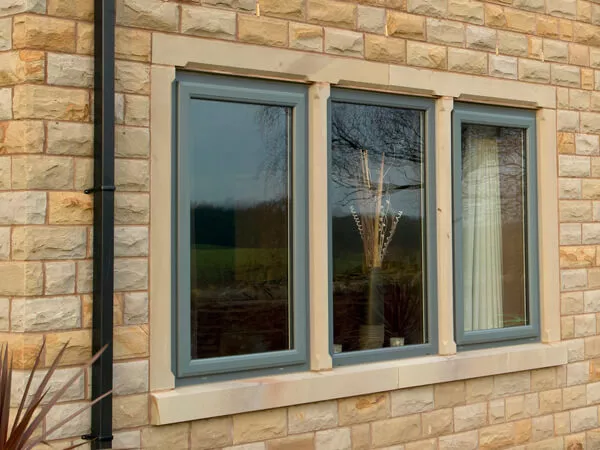
- Features
Being side hinged, the casement opens outwards, enabling you to harness the design for attracting ventilation and boosting the perspective of outdoor landscapes. Sealed tight for optimal energy efficiency, a casement has a tight lock too. - Best for
Highly suited to contemporary residences and traditional dwellings. Therefore, a very reliable choice. - Efficiency Rating
Casement windows have the potential to attain impressive thermal efficiency ratings so long as they are well-sealed on closure, embrace insulating materials and house double or triple glazing. - Design Options
Most are crafted from UPVC, aluminium or timber into classic, modern and heritage styles that can adorn largely all colour hues, including a range of woodgrains. - *Average Cost
The costing of a set of casements will rest on what window sizes you need, any customisation requirements, the desired material and glazing. ⭐ ⭐ ⭐
Sash Window
Sash windows originate from the Georgian and Victorian eras, initially coming to prominence at the end of the 17th century.
Their original design would be wood-built, but nowadays, most sash windows have UPVC or aluminium frames and much larger glazed expanses than of old.
Elegant and charming at the same time, you open and close a sash style by sliding the panels either vertically or horizontally.
Although they’ve been around in this country for close to 400 years, there are no signs of the sash window losing its appeal.

- Features
Vertically or horizontally slide the sash/sashes to create an opening that nicely regulates light and airflow. An uppermost advantage is how much it simplifies cleaning. - Best for
Employ their design if wanting to instil some traditional elegance at a modern abode or to uphold the historical architecture of classic dwellings. - Efficiency Rating
Capable of fulfilling medium to high energy efficiency on the assumption of them containing high-performance glass and being sufficiently insulating. - Design Options
Request the sash style in UPVC, aluminium or timber profiles, single-hung, double-hung or sliding, and almost any kind of shade, not just white. - *Average Cost
The price-range of a sash window varies according to what you request, however a group of them will normally come in at the mid to high-range price point. ⭐ ⭐ ⭐ ⭐
Tilt and Turn Window
A huge favourite in continental Europe, tilt and turn windows have exceptional security, insulate impressively and couldn’t be simpler to preserve.
No window style has an opening mechanism quite like a tilt and turn – enjoy an ability to slightly tilt the design open at the top or swing it open, as you would with a traditional door.
This dual functionality is a major attraction to people who have a high priority of window flexibility and want utmost home security.
The practicality is why you so often see tilt and turns chosen as an enhancement at modern properties, but that’s not to say they aren’t also suitable for older home accommodation.

- Features
Two opening options entailing either a partial tilt at the top to lure in some airflow or an inward swing of the design, removing the difficulty of cleaning. - Best for
Tilt and turns conform with modern apartments, current-day residences and high-rise buildings. - Efficiency Rating
Contemporary thermal demands will be met as a tilt and turn encompasses a multipoint locking mechanism, double or triple glazing, airtight sealing and other essential components. - Design Options
Aluminium versions are available, but UPVC is mostly harnessed to sculpt tilt and turn windows. Common hues include white, black and Anthracite Grey and designs range from single-pane and multi-pane to full-height and floor-to-ceiling offerings. - *Average Cost
In general, they cost more than casement windows but are by no means expensive. ⭐ ⭐ ⭐ ⭐
Sliding Window
A sliding window has much in common with a patio door, as you similarly slide the sashes horizontally across the tracking system to engineer an opening.
They move with equal smoothness and the opening method of a sliding window style proves useful when you’ve little room to play with in close proximity to the designs.
Exploit the sliding mechanism to entice natural light inwards and simultaneously, ample ventilation.
No matter where sliding windows take up residence, they promise lasting robustness and fast, efficient useability.
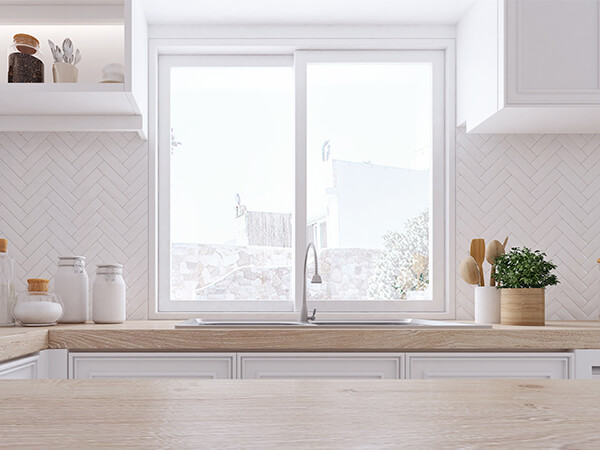
- Features
Involves the horizontal manoeuvring of the window across a track, avoiding it from occupying internal or external space when open like other window arrangements. Relied on for ventilation, easily operable and space-saving. - Best for
An excellent match for minimalist present-time properties and those mid-century houses that gravitate toward horizontal lines and open views. - Efficiency Rating
Provides moderate thermal efficiency ratings, but this can be advanced with the deployment of double glazing and insulating framework. - Design Options
Your conventional sliding window will be composed of UPVC or aluminium, accommodate single or double-sliders, and be finished in white, grey or black. - *Average Cost
Sometimes, window sliders require less investment than casements, but that will pivot on what the required sizes are and how much tailoring is specified. ⭐ ⭐ ⭐
Bay Window
Right up there as one of the most prominent types of double glazed windows would have to be the bay window due to how it reaches out from a home.
For the most part, bay windows incorporate three glazed sections – one big central window flanked on either side by two smaller windows – either operable or fixed.
Bay windows create a feeling of space in rooms, also down to their extra depth and the natural light they file inside in large quantities.
The usual location for a bay window will be in a main living area, fashioned into a traditional or modern aesthetic and somewhere occupiers will often sit to watch the world go by.
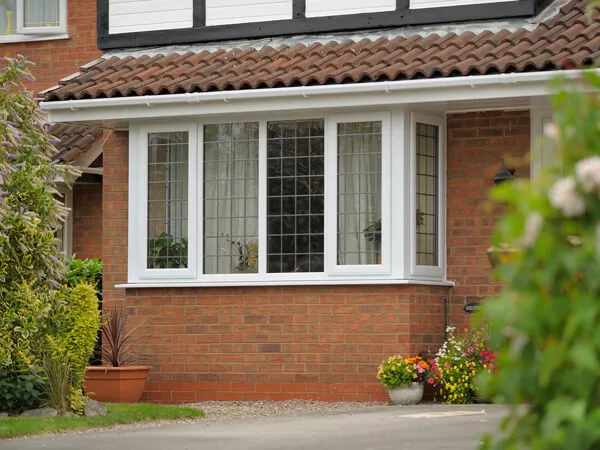
- Features
An outward protrusion ensures that a bay window bathes an internal space with light and exaggerates external views. The distinct window formation makes it a prominent house feature. - Best for
One or two bay windows cohere beautifully with period and Victorian homes, intensifying existing charm. - Efficiency Rating
A wealth of surface area necessitates use of energy-efficient glazing so that a bay window can arrest heat loss and achieve bountiful thermal levels. - Design Options
Modern and traditional bay windows constitute UPVC, aluminium or wood frames and are historically coloured white, cream or lavished in a believable woodgrain. - *Average Cost
A three-section bay is obviously cheaper than a five-sectioned design and material and glazing choices will also come into it. The elaborate configuration puts a bay into a higher price bracket than a standard window. ⭐ ⭐ ⭐ ⭐
Bow Window
A bow window projects outward from a wall like a bay window, but it has a more rounded and arc-like shape. The less sharply angled four or six panes are all equal in size.
Bedrooms are as popular for bow windows as living rooms, and they share a bay window’s capacity to invite the light in from outside and foster captivating views.
Regardless of being UPVC, aluminium or timber-made, the bow window is always an architectural highlight of a home.

- Features
Multi-panelled with either fixed or operable window facets, bow windows are flawlessly curved and manage to inspire heightened brightness internally. - Best for
A strong fit for period homes, Victorian-type properties and ultra-modern residences where deepened light gain and flair is sought. - Efficiency Rating
If effectively sealed, well-insulating and double or triple glazed, bow windows can realise medium thermal efficiency ratings. - Design Options
Traditional and modern bows are shaped using UPVC or aluminium and finishes outside of white, black and wood tones can be nominated if these won’t work. - *Average Cost
A casement or sash window doesn’t have as much of a complex design, hence a bow window costing more. ⭐ ⭐ ⭐ ⭐
Rooflight/Skylight window
Practically the same thing, rooflights and skylights mostly feature in the roofs and ceilings of lofts and extensions to compensate for them maybe having a lack of windows for light transference.
They are employable as a source of ventilation if you stipulate an opening mechanism.
Toughened or laminated glass is resident in the UPVC or aluminium framing so that you benefit from relentless insulation and weatherproofing.
Reliance on artificial light will be much reduced as a rooflight/skylight funnels copious amounts of light into new and traditional homes.
Apt for new and traditional building styles, the funnelled light brought about by a rooflight or skylight will decrease your dependence on artificial lighting.
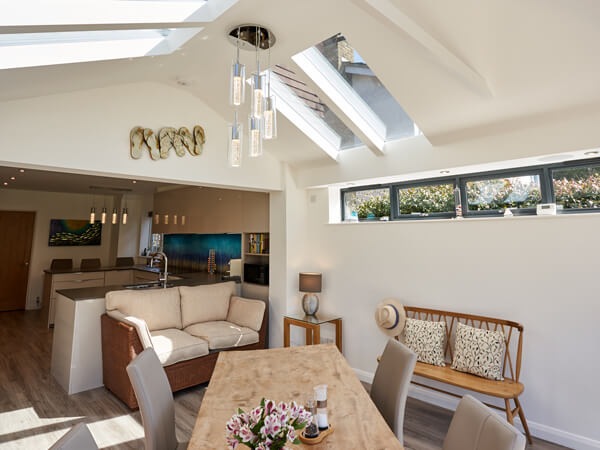
- Features
Inserted into roofs, the fixed or vented window feeds a room with light, brokering a vibrant feel inside and consequently, signalling spaciousness. - Best for
Loft conversions, extensions and modern residences with insufficient wall space for windows. - Efficiency Rating
A double or triple glazed rooflight or skylight that’s insulated throughout will promote thermal efficiency, restrict heat loss and the need for artificial light. - Design Options
You can have a wide range of rooflight and skylight styles, such as fixed, manual, electric opening, flat roof and pitched roof options in UPVC or aluminium, mostly coloured white, black or grey. - *Average Cost
What kind of rooflight/skylight you ask for and the desired size will influence price – cost goes up with size.⭐ ⭐ ⭐ ⭐
Flush Window
Your standard window style has a slight overhang, whereas a flush window doesn’t, sitting perfectly flat against a wall, making it a highly distinctive window type.
Commonly employed at modern residences, present-day flush windows incorporate energy-efficient glazing and have a UPVC frame, rather than a timber profile, not that you’d realise as they are finished to mirror the appearance of wood.
Unbelievably slick, the flush window boosts light capture and allays any danger of water ingress eventuating.
Compared with your traditional flush window, the modern reinvention of a flush design needs a fraction of the maintenance.
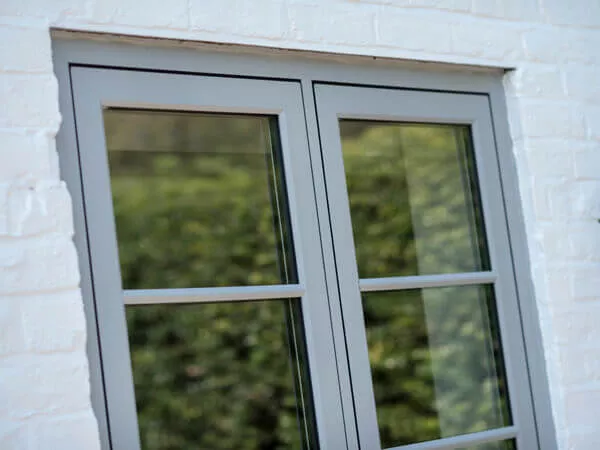
- Features
Flush windows establish a beautifully dapper home aesthetic as their alignment with an exterior wall is inch-perfect. - Best for
Agreeable with contemporary and period properties thanks to an exquisitely streamlined appearance. - Efficiency Rating
Regardless of a flush window’s trim composition, on being double or triple glazed and thoroughly insulated, it can achieve very respectable thermal standards. - Design Options
A couple of centuries ago, flush windows would be forged out of wood, but as technology has advanced and time has moved on, UPVC and aluminium are the two materials routinely used to construct them. - *Average Cost
The price of flush windows will be influenced by how much customisation is involved. They are fractionally more expensive than standard casement windows in most cases. ⭐ ⭐ ⭐ ⭐
Request Your Free Window Quote
Simply fill in your details for your free, no obligation quotation
What Window Type is Right for My Home?
The right window type will be whichever complements your home’s personality and is in sync with its age.
Double glazing is a minimum requirement if you want new windows to supercharge your house with warmth, rid it of draughts, significantly lower heating usage and protect against future condensation on windows.
You mustn’t turn a blind eye to security either, checking that any replacement designs have a string of secure mechanisms, including robust hinges and a multipoint lock.
Security mustn’t be overlooked, so insist on types of house windows that are loaded with secure components, such as a multipoint locking mechanism.
Personal taste comes into play as well, so choose something that is likely to have ever-lasting appeal, both from your perspective and others.
When all is said and done, it’s about uncovering windows offering an evenness of functionality, ravishing looks and first-rate thermal qualities.
What Are the Different Categories of Window Frame?
If we’re purely talking about residential buildings, the four main categories of window frames are as follows: UPVC, aluminium, composite and timber – as we’ll elaborate on:
- UPVC
Abbreviated to UPVC, unplasticized polyvinyl chloride window frames are thermally insulating and simple to maintain due to being resistant to corrosion, rotting and fading. They also have great sturdiness and can be bought in countless styles and colours. - Aluminium
You’d assume that aluminium window frames are very weighty, but they’re unbelievably light, yet unrelentingly resilient. The flexibility of aluminium enables it to be shaped into many forms and it rejects erosion. - Composite
A composite window consists of a series of matter, including wood and plastic, fused together. Bearing a strong resemblance to timber windows, they aren’t liable to contract or warp like wood and insulate extremely well. - Timber
Every timber window displays a unique aesthetic, featuring one-of-a-kind contours and patterns. Natural wood’s biggest drawback is that you find yourself forever treating it, whether that involves habitual painting or re-staining.
Which Window Style Comes in Cheapest?
The cheapest out of the different types of windows discussed will be determined by what material, glazing and frame is specified.
UPVC casement windows are generally an inexpensive option as UPVC is a low-cost material, and to keep the price down, accept double glazing units for these styles of windows instead of triple glazed units.
It sounds obvious, but the more straightforward the style and your preferences, the less money you’ll need to fork out.
Which is The Best Type of Window Opening?
Govern that verdict based on whichever type of window openings obey your practical necessities and aesthetic desires.
Before signing off this article, let’s reiterate some of the main points so that you have a definitive understanding of the advantages of each window type and know exactly what you’re buying.
- Casement windows
Hinged on the side, open outwards, convenient for collecting fresh air and light indoors. - Sash windows
Very traditional with a vertical or horizontal opening mechanism, allowing a small dose of ventilation. - Tilt and Turn windows
Offer an inward tilt at the top or can be swung inwards to attract maximum ventilation and simplify cleaning on the inside and outside. - Sliding windows
Comprising one or more horizontal slide panels that don’t take up valuable space, fostering generous airflow. - Bay windows
Have an outward angled shape and are multi-panelled, bringing depth and added space to a room. - Bow windows
Curved like a bay window, but with more panels, they also entice light and suggest spaciousness in rooms. - Rooflight/Skylight window
Fixed into roofs and largely present in lofts or rooms with minimal wall space, they can be operable if you’d value some overhead ventilation. - Flush windows
Mostly sold in the casement style, the precise flush finish creates a beautifully sleek effect.
Key Takeaways
There’s much to take on board then when talking through types of windows for the home but keep our key takeaways in mind and you can’t go wrong!
On scrutinising types of house windows, become familiar with the different styles so that you are well up on the intricacies of them all, including how they function, the standard of energy efficiency provided and what they cost.
Lastly, make certain that any replacement windows are sympathetic to the house, requiring thorough analysis of frames and glazing.
*Price rated from 1-5 stars (1= very low cost, 5= expensive)
Looking for new replacement windows?
Old favourites such as the Sash Window and Casement Window, sit alongside contemporary innovations including our latest flush range available in double glazing or triple glazing options.
REQUEST YOUR FREE QUOTE
Simply fill in your details for your free, no obligation quotation, and click "Get Quote"